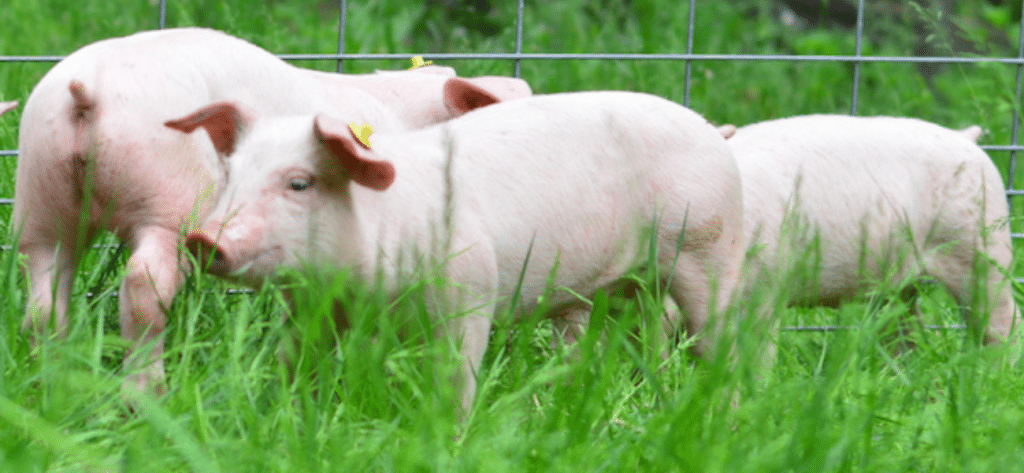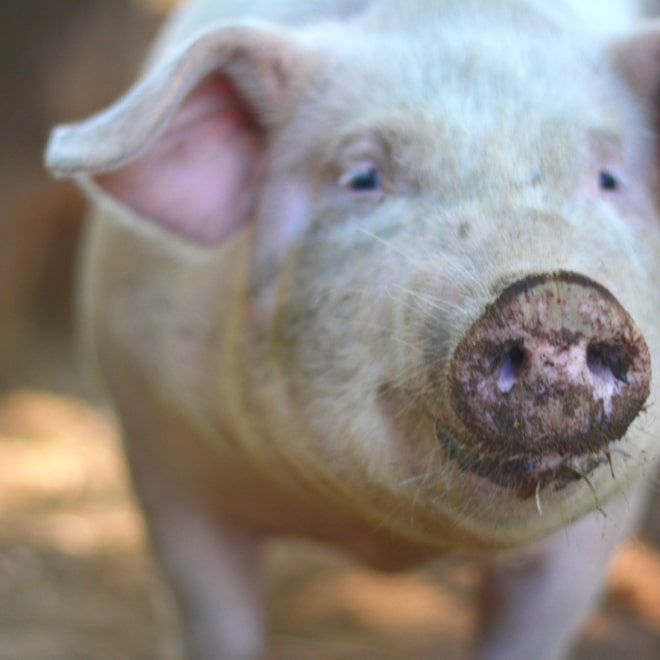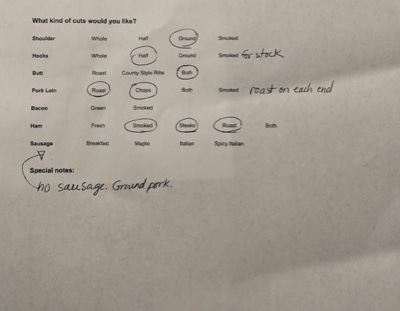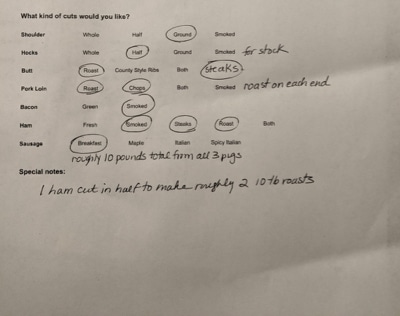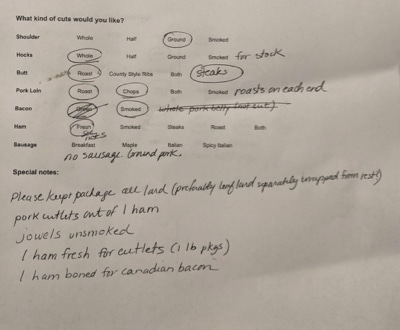Last Updated on June 20, 2024 by Michelle
Processing pigs at home? It wasn’t what we originally planned it, but it turned out to be the perfect way for us and for our pigs.
This article will explain our process of having a traveling butcher come to our homestead. It will not break down details of how you can butcher yourself, but instead will show you the process and explain why this option may be perfect for you.
Go here for details on raising pigs on pasture.
Finding a Butcher
We decided the best way to find a butcher was word of mouth, relying on the opinions of folks we know and trust to tell us their experiences. We then started calling all the butchers that friends (or friends of friends) had good things to say about.
We quickly found out that every butcher we called, in May, was already booked through the end of the year. I was told this was worse than usual for our area, due to the craziness of 2020. With the pandemic and the insane food shortages reported across the country during the summer of 2020, apparently we weren’t the only ones who were raising livestock that would need to be processed before the year was over.
We were elated to finally hear back from a butcher who was willing to add our pigs to his processing list. Never mind that he was about 1 1/2 hours north of us.
We knew it would be a royal pain to cart our pigs that far and then make the trip again to pick up the meat after it was cut, prepared, and (some of it) smoked. But at least this was hope that we wouldn’t have to feed our pigs through the long cold winter, which would have almost doubled our costs in the end.
Our Delay Almost Cost Us A Lot!
As butchering time neared, the butcher we had chosen told us he had to bump us down on his list. He kindly explained that the demand for butchering was through the roof and he just didn’t have enough hours in the day.
Apparently many people, like us, added more homegrown meat to their list of priorities in the midst of a pandemic.
I should also point out that he would not have bumped us down his list is we had been regulars with him. The fact was, we had never processed an animal with him before and he felt he needed to give priority to his regular customers and their increasing demands.
Makes sense, but it also made it clear to me that, if possible, we needed to find a butcher we loved and stick with him, not drive to one super far away, out of desperation.
While at first it sounded like we’d get in a few weeks later, so no biggie, then I kept calling weekly, to get a definitive date. I found out we had been moved down to January.
A three-month delay.
That’s a lot of extra pig food, folks.
One lesson I took away from this? If you’re on a wait list for a butcher, keep calling and checking in with them. If not, and you get bumped, he probably won’t go out of his way to let you know this.
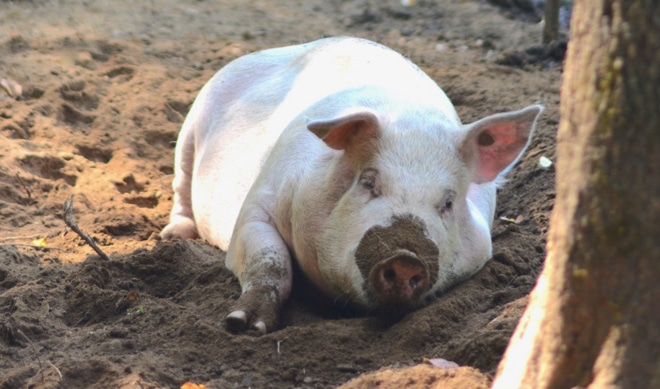
It’s Good to Butcher in the Fall
As the temperatures turn colder in the fall, pigs have to spend more energy staying warm. Which means they eat even more food and burn off more fat. So not only would a delay until January mean hundreds of dollars more each month on food, but in the end we would have had less meat for us.
Plus, spring pigs don’t eat a lot in the spring, because they’re little. But as each month progresses, and they grow larger (it happens quickly!), your feeding costs grow exponentially.
Trust me, pigs like to eat.
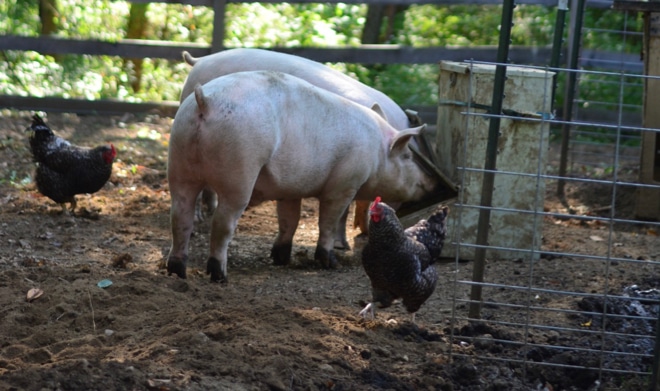
Consider Processing your Pigs at Home
Around this time of agonizing delay (with zero other butchers available, that I knew of), I was reading a great little book, The Complete Book Of Butchering, Smoking, Curing, And Sausage Making.
The author, a professional butcher himself, explains how the animal’s stress level at time of death (in addition to its temperature and overall health) can have a huge impact on the meat… on its texture, pH, moisture, and color. That got me thinking.
Ever since the day we brought those piglets to our homestead, they’ve spent their entire lives rolling around and eating joyfully in a shady open field of grass, tree stumps, and mud.
I seriously love it that we can give these guys a good life. One that any pig would envy. 🙂
And surely that first trip–in the dog cage strapped onto the back of our pickup truck–was not as stressful on them as this final trip would be…
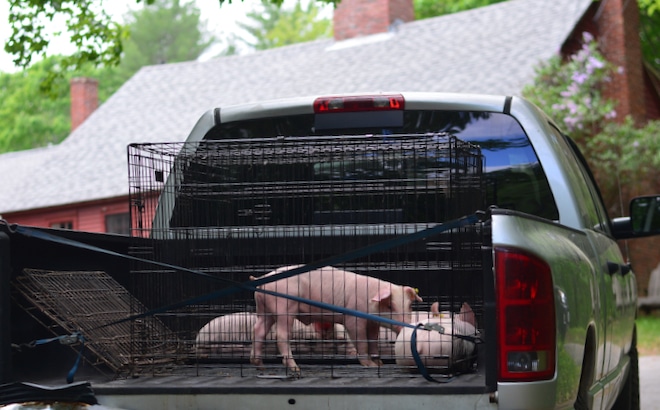
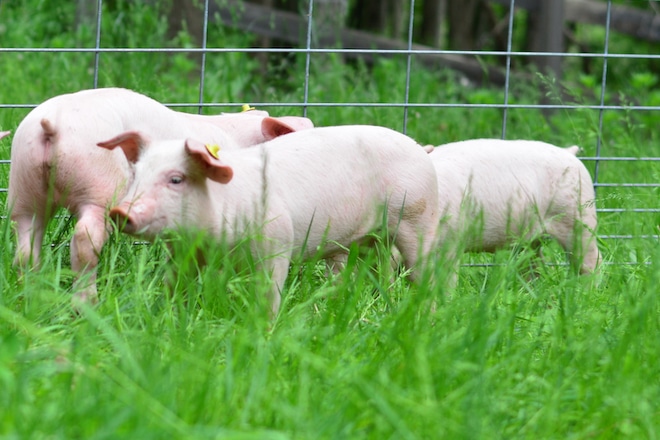
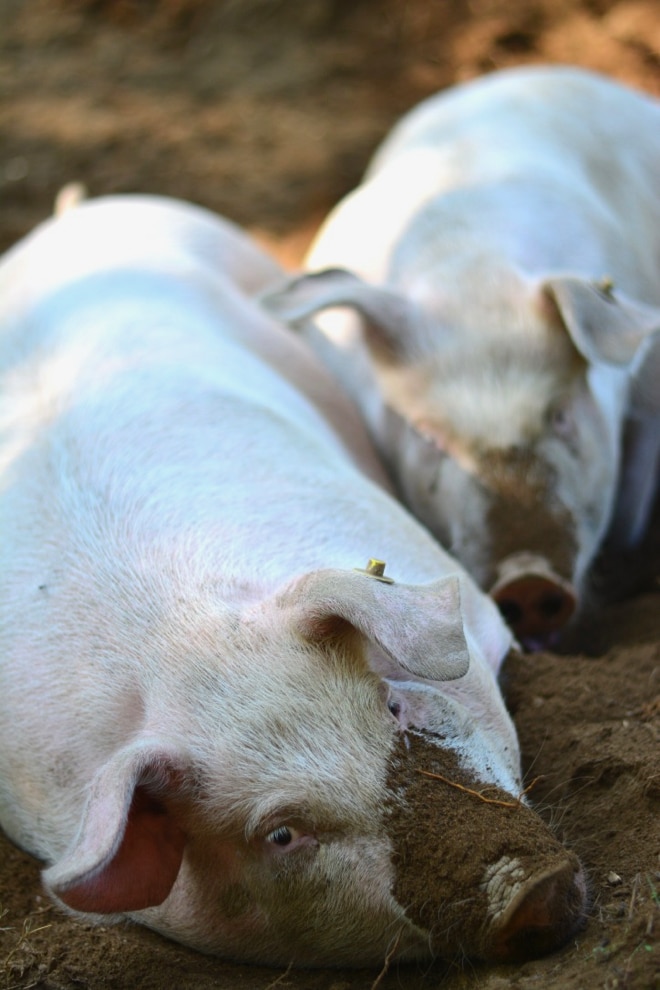
Getting loaded onto a formidable trailer would not only be complicated for us. These pigs had grown from tiny little pig cuteness to giant, muddy, HEAVY pigs. All weighed almost 400 pounds each, and they’re not exactly on voice command 🙂
btw, yes, you read that right. Our 3 American Yorkshire pigs weighed a combined hanging weight of 1,098 pounds. That equates to 70 pounds of bacon, in case you’re wondering. (That was the first thing I wanted to know. 🙂 )
But I started thinking about how stressful that might wind up being for the pigs, the long ride, getting jostled and bumped around in that big, foreign trailer, with loud noises.
Not to mention being corralled into the butchering facility and waiting for slaughter.
That sounded like a whole lot of stress to me. And now I was realizing this would impact the texture, pH, moisture, and even color of our pork? Hmmmmm…
Things to Look For in a Butcher
At this point, in desperation, I talked to everyone I knew (and a bunch of strangers) and the angel choirs broke out in Handel’s Messiah (yeah, maybe a slight exaggeration) when I found Michael.
Michael was not FDA certified. But his referral came with great accolades and his shop was super clean and organized.
The fact that Michael was not FDA certified, for me, comes down to the fact that I can’t sell the meat in individual cuts. But my state laws do permit me to sell a whole or 1/2 of a pig. Don’t ask me the reasoning behind this… but we roll with it.
Reach out to me on instagram or shoot me an email at soulyrested(at)outlook.com if you’d like to know how you can get on our waitlist.
Needless to say, when we found him, we got on Michael’s calendar right away.
Things to ask a Potential Butcher
- Ask if they can come to you.
- Ask how they wrap the meat. Some folks prefer vacuum sealed. I actually prefer freezer paper.
- Ask if they smoke the cuts, and if so, do they personally do it for you or outsource it. Or do you have to find a smoker?
- Ask if they have a few set ways they prefer to cut the meat or if they are willing to work with your requests.
- Ask for their cut list and if they can walk you through the options.
I was so thankful that Michael sat at the kitchen bar with me for 45 minutes after finishing butchering the 3 pigs. He nursed a cup of coffee and warmed up in front of the fire we had going in the kitchen fireplace, while patiently answering every question I had (and there were a lot).
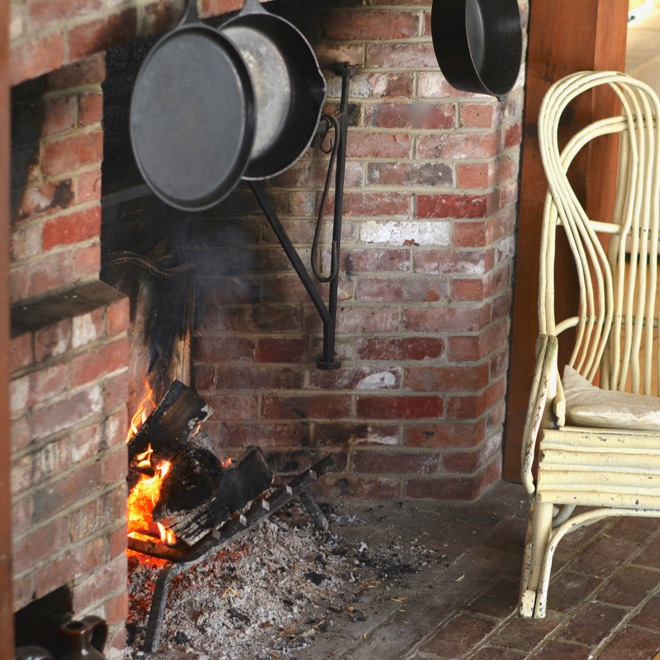
Because he was patient with me, I was able to narrow down exactly what i wanted (it varied from pig to pig, because i wanted to experiment with a few unique cuts. And I wanted to cure some myself and render lard, but I also wanted to stick with more traditional options too. You know, in case i royally mess up and order cuts we don’t like, or in case I am not successful at curing.
As we talked through my options and my requests, Michael told me exactly what to write on each cut paper, for each pig.
I’ll be honest. I had looked at those papers for weeks and hadn’t filled out one thing, so unsure of the whole process.
A good butcher makes it easy.
Before Butchering Day
Before butchering day, talk with friends who have done this. Find out what cuts they liked and ask what they would have done differently.
I gathered suggestions on everything from lard rendering techniques to ways to use the jawls of the pigs, and I felt well “armed” for the whole process.
Also ask the butcher what he will bring, and what you need to have ready. For us, it was a matter of having the tractor out and ready. That was it.
NOTE: Needless to say, this article does include pictures of pigs that are being processed. They are respectful of the animals and nothing bloody and gory (infact, there was very little blood and no gore at all on processing day), but I thought I should mention that before you scroll on.
What to Expect When Processing Pigs at Home
The traveling butcher will process the pigs one at a time. Once one is done and in his truck, he’ll start the next one.
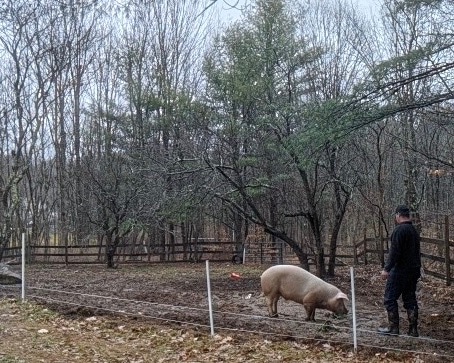
He will shoot the pig in the head, carefully doing so at just the right angle so his shot is effective but your meat is untouched. The pig may flail around a minute or so, with its front and back legs kicking rapidly. This is a normal response of the nervous system caused by the stun, but rest assured your pig is no longer conscious.
Meanwhile he will slit its carotid artery (aka its throat), to let it bleed out quickly. Then the pig will suddenly be totally still.
From shot to hanging is only a few minutes.
Using a large s-hook, he will secure one of the pig’s back hooves to the tractor bucket (or use a tripod he will bring if you don’t have a tractor suited for the job).
Then he will cut open the pig, down the length of its belly and extract all the organs, setting aside any you’ve requested {(read this post to see what I ask for… heart, liver, lace fat around the stomach)}
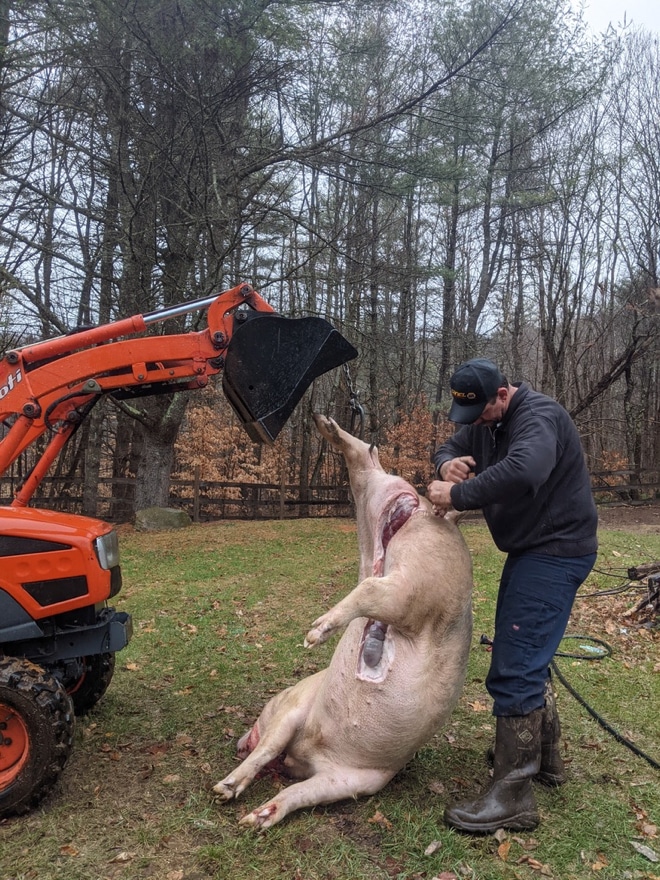
At this point, he’s ready to get the carcass in his truck and move on to the next pig, repeating the steps again until all the pigs are processed and on his truck.
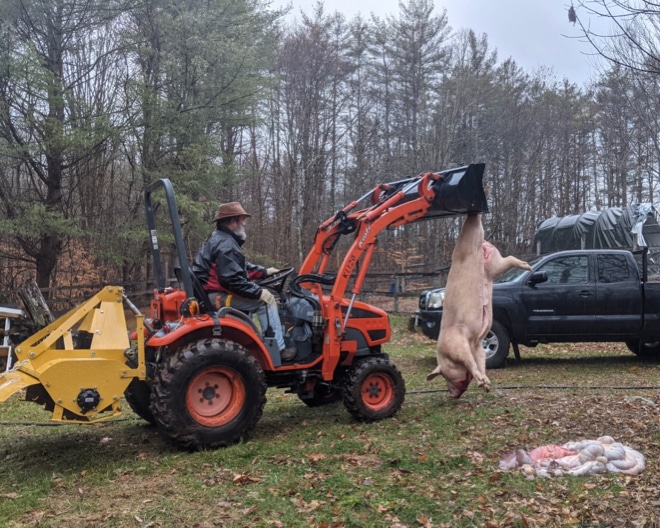
It was very convenient having the tractor and being able to drive the heavy pig carcass right up and plop it on his truck bed. For the 3rd pig it was easiest to lower him on his back onto the ground then scoop him up in the bucket to transport him over and roll him out on top of the other 2 carcasses.
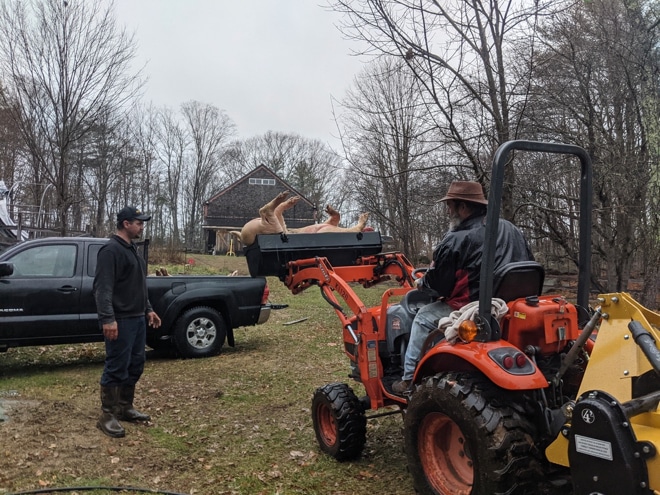
Sidenote, I guess if we had the right set up, a butcher will scald and scrape the pig at our home as well, but we don’t.
After the butcher has driven away, you will have to decide how to dispose of the internal organs you didn’t want to keep. Bill simply dug a hole with his backhoe and buried it all. You could also contact your local dump and ask if they allow animal disposal.
Our Overall Thoughts on Processing Pigs at Home
In the end I’m thankful that we had so much difficulty finding a butcher. And I’m very glad the one who was a long drive away bumped us down his list, forcing us to consider butchering at home.
Bill kept saying how shocked he was that it was so “clean,” we thought we’d have lots of gory, bloody mess to clean up. Truth be told, processing a few chickens leads to much more mess than this did.
But for me, the biggest blessing was the fact that our pigs had a truly simple, stress-free end. I’m also elated that that translated to absolutely delicious meat for us as well.
The picture below happens to be my favorite of the many hundreds that I took over the 7 months that we had the privilege of raising these pigs. I snapped this just a minute before this pig was dead and hanging. He was frolicking happy in the messy mud just seconds before he was being processed.
For me, processing pigs at home was the last great way that we could truly give our pigs a good life. Making their last moments happy and stress-free was the least we could do in exchange for all the joy they have brought us.
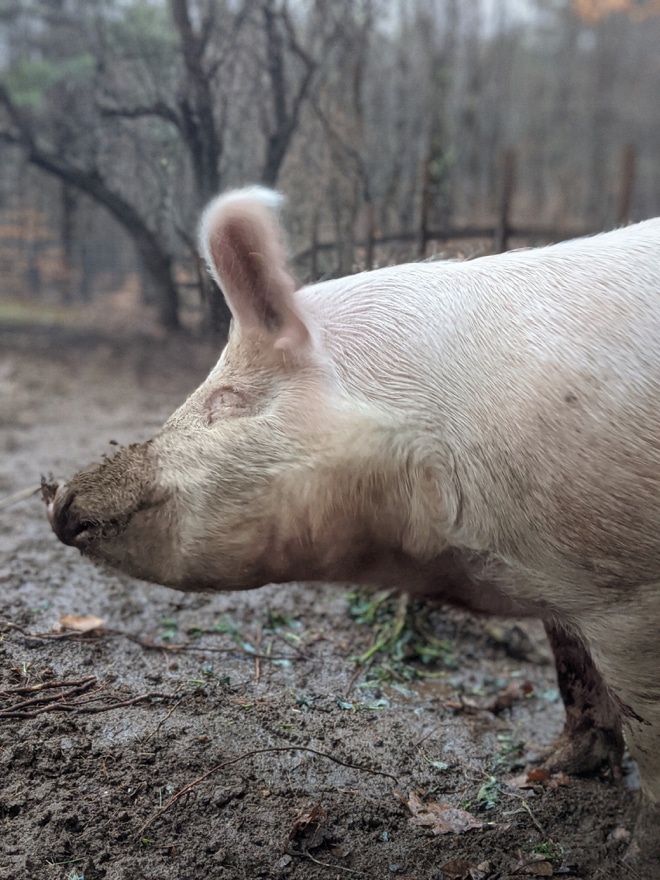
What Happens After Butchering Day
While your butcher will have a good idea of an estimate of the weight of your pigs and the amount and quality of the meat, it will most likely be many days until you know the actual hanging weight.
You’ll pay him for the slaughtering fee, a set fee per pig, or a set amount you agreed to ahead of time, then pay him per pound of hanging weight when you pick up your meat, all cut, prepared, and wrapped for the freezer.
What We’ll Do Differently Next Time
We truly loved our butcher. He was willing to sit with us with a cup of coffee in front of fire and chat for 45 minutes after the butchering, answering all my questions about options of meat cuts and helping me fill out the cut sheet just the way we wanted things.
But now that we’ve done this once, we know a few things. We know what cuts are our favorites and what are are least favorites.
The cuts we favor least we can ask him what other options we have next time for that section of meat. For instance, if I’m not crazy about having 6 large ham roasts I can ask him to cut them into ham steaks for the grill instead. If we don’t want so many loin roasts or ribs or Canadian bacon (ummmm, yeah, no, I won’t ever say that) we can ask for him to make more ground pork or breakfast sausage out of some of those cuts that we don’t want so much of.
For our family, these were the things we’ll do differently next year with our butcher requests:
- We only had him give us 10 pounds of breakfast sausage because we wanted to experiment with making our own. But his were delicious and we decided we like the ground sausage almost as much as the casing sausage, which is a lot more difficult to make, so next time we’ll let him do more of that work. (We used these to make our link sausage.)
- Yet we will also want to make our own next time as well. Even though I don’t want to make a lot of casing sausages, I do love them. So I will plan how much I want to make and ask him to go ahead and package up some larger packages of ground meat for that purpose. No need to unwrap a dozen little packages when I know I want 12 pounds of meat for sausages.
- We were disappointed that the butcher packaged two ham steaks in every pack. And these are big, thick ham steaks. Next time we will specify how much meat we want in each individual package of each cut.
- While I loved rendering our own lard (okay the rendering wasn’t overly exciting, but using it sure is), folks have told me recently that their butcher removes the skin for them and even grinds it up for them so all they have to do is plop the fat in the pot. Ummmm, yes please.

What’s next?
This is just the first in an upcoming series about raising and processing pigs and cooking many cuts of pastured pork. Go here to get delicious pork recipes in your inbox.
And be sure to find out the 6 Things You Need to Know when you’re Raising Pigs on Pasture
If you’d like to follow along as we were raising these pigs, check out the highlight about them on my instagram account.
Edited to Add: I saved a second set of ig stories on raising our second round of pigs right here.
Other articles about raising animals on the homestead:
How To Train Your Dog to be Chicken Friendly
Should you Raise Chickens or Ducks?
The Worst Mistake I Ever Made with my Chickens
3 Secrets Legit Homesteaders Might Not Tell You.
Pin this for later!
Click on the image below to pin this post.
Find out why SoulyRested was considered to be one of the Top 20 Must-Read Homesteading Blogs of 2018 and then one of the Top Homesteading Blogs of 2019 as well.
Glance at my Resource Page if you’d like to get a glimpse of all the supplies I use and recommend for everything from gardening, to homeschooling, to chicken care, to nature journaling, to maple syrup making.
I’d love to connect!
To find me in some other neck of the woods, just click any (or every!) icon below:

